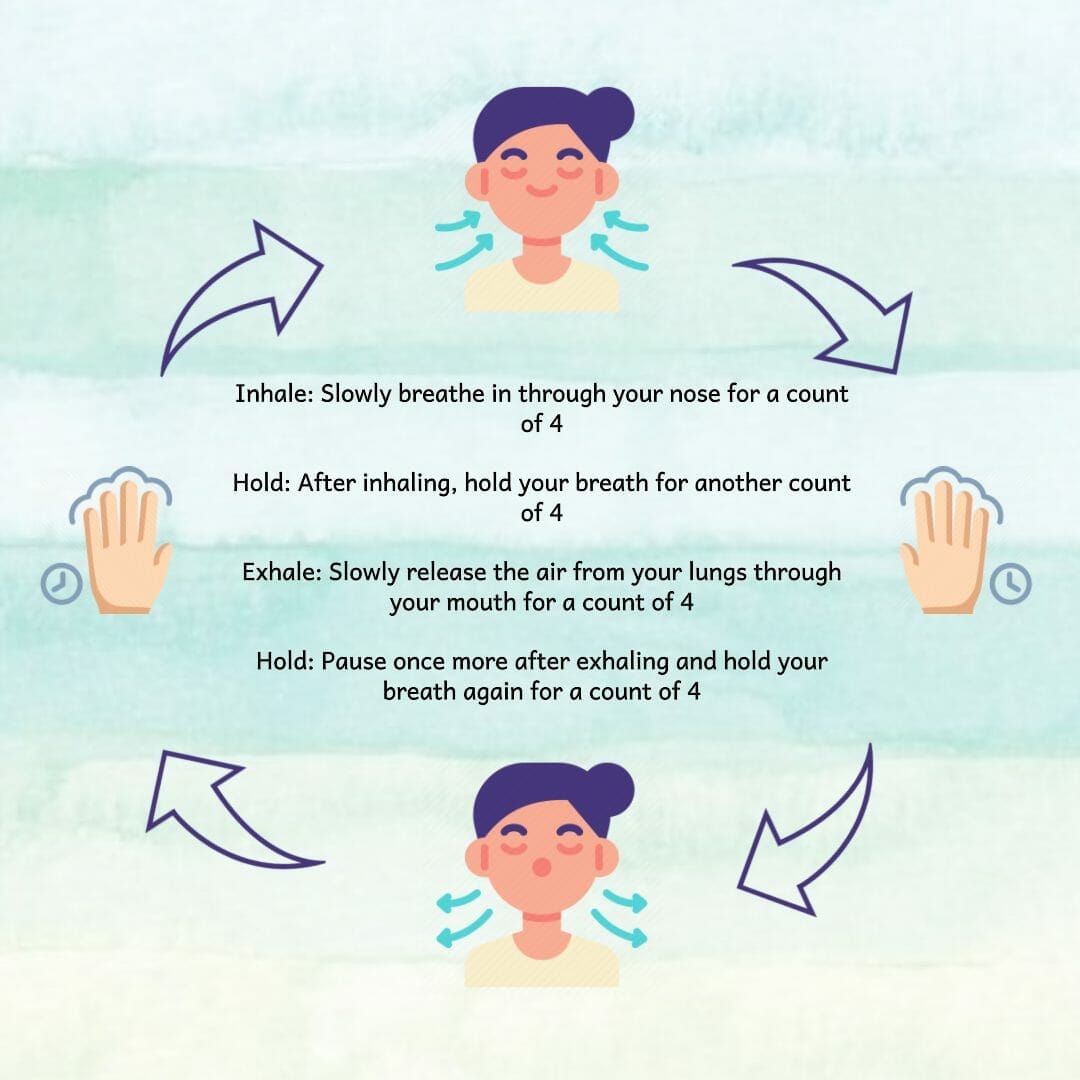Feeling stressed, anxious, or overwhelmed? It’s time to focus on your breath and regain control with the Box Breathing Technique. This proven relaxation method has been utilized by Navy Seals and professionals alike to improve focus, increase productivity, and manage stress.
Throughout this comprehensive guide, we’ll explore the benefits of Box Breathing, provide step-by-step instructions for beginners, and share tips for incorporating it into your daily routine.
Key Takeaways
- To perform the box breathing technique, inhale for a count of four, hold your breath for a count of four, exhale for a count of four, and then hold your breath for another count of four.
- Practicing box breathing regularly can lead to significant reductions in physical symptoms associated with stress and anxiety such as lowered blood pressure and heart rate. It may also help improve cognitive performance by increasing mental alertness and concentration.
- Finding a quiet and comfortable place to practice box breathing is essential. for getting the most out of this relaxation method. Beginners should start with shorter sessions before progressing onto variations. once they feel more confident.
What Is Box Breathing?
The Box Breathing method consists of taking deep breaths while holding the air for four counts, followed by exhaling and similarly holding for another four counts. This pattern is repeated throughout the exercise.
Definition And History
Box breathing, also known as square breathing, is a simple yet powerful deep breathing technique that has been practiced for centuries across various cultures.
The concept behind box breathing is quite straightforward – imagine your breath traveling along the four sides of a square. The technique involves inhaling deeply for a count of four, holding your breath for another count of four, exhaling slowly to the same count, and finally pausing again with empty lungs for an equal duration before starting anew.
This cyclical pattern allows you to gain control over your breath while simultaneously activating your parasympathetic nervous system (the “rest and digest” state), ultimately leading to increased relaxation and mental clarity.
The Four Basic Steps Of Box Breathing
Practicing the box breathing technique can greatly benefit self-growth enthusiasts, people dealing with anxiety, and those seeking relaxation. The four basic steps of this deep breathing exercise are as follows:
- Inhale: Slowly breathe in through your nose for a count of four, filling your lungs completely.
- Hold: After inhaling, hold your breath for another count of four, making sure not to strain yourself.
- Exhale: Slowly release the air from your lungs through your mouth for a count of four, ensuring that all the air is expelled.
- Hold: Pause once more after exhaling and hold your breath again for a count of four before repeating the cycle.
Incorporating these simple yet powerful steps into your daily routine can help you reduce stress and anxiety levels while promoting a sense of relaxation and mental clarity when you need it most.

How It Works
Box breathing works by regulating your nervous system, helping you achieve a state of relaxation and calmness. When we experience stress or anxiety, our bodies tend to switch into “fight-or-flight” mode, activating the sympathetic nervous system.
By practicing box breathing, you activate your parasympathetic nervous system – responsible for promoting rest and digestion – effectively counteracting the effects of stress.
Each step of this technique is done in counts of four: inhale for four seconds, hold the breath for another four seconds, exhale slowly for four seconds, and then hold again before repeating the cycle.
For example, imagine finding yourself overwhelmed by anxiety before an important presentation at work. You could practice box breathing to reset your focus on being present rather than getting lost in negative thoughts or feelings.
Benefits Of The Box Breathing Technique
Box breathing has numerous benefits, including reducing stress and anxiety, increasing focus and productivity, improving sleep quality, and lowering blood pressure.
Reduces Stress And Anxiety
I have found that practicing the box breathing technique has been incredibly helpful in reducing my feelings of stress and anxiety. The deliberate, slow breathing involved in this technique can help activate the parasympathetic nervous system, which promotes relaxation throughout the body.
Studies have shown that practicing box breathing regularly can lead to significant reductions in physical symptoms associated with stress, such as lowered blood pressure and heart rate.
Additionally, it may help improve cognitive performance by increasing mental alertness and concentration.

Increases Focus And Productivity
Box breathing can also increase your focus and productivity, making it a valuable tool for anyone looking to boost their mental performance. By controlling your breath and engaging in deep diaphragmatic breathing, you activate the parasympathetic nervous system which promotes relaxation, soothes frazzled nerves, and helps you control anxious thoughts.
Research has shown that adopting box breathing as part of your daily routine can help improve cognitive performance. Former navy seals, athletes, and musicians have all reported using the technique to stay calm under pressure while maintaining high levels of focus.
Improves Sleep Quality
As someone who has struggled with sleep issues due to anxiety, I know firsthand how frustrating it can be to lie in bed at night, unable to turn off my thoughts and relax.
This is where box breathing comes in as a game-changer.
Research studies have also shown that incorporating box breathing into your daily routine can reduce stress levels and increase feelings of relaxation. This makes it an effective tool for anyone looking for natural ways to improve their sleep without resorting to medication or other interventions.
Lowers Blood Pressure
In addition to reducing stress and anxiety, practicing box breathing can also help lower blood pressure. When we experience stress, our body’s natural response is to release cortisol, a hormone that raises blood pressure.
By practicing deep breathing techniques like box breathing, we can counteract this response and reduce the amount of cortisol in our system.
If you’re someone who deals with high blood pressure or simply wants to maintain healthy levels, incorporating box breathing into your daily routine could be an effective tool.
Remember to find a quiet and comfortable place where you won’t be interrupted before beginning your practice. Try inhaling for four counts, holding for four counts, exhaling for four counts, then pausing again for another count of four – repeating as needed throughout the day.
How To Practice Box Breathing Technique
To practice the box breathing technique, start by finding a quiet and comfortable place. Then follow the four basic steps of inhaling, holding your breath, exhaling, and holding your breath again for four seconds each – but read on to find out essential tips for beginners and add variations to the technique.
Find A Quiet And Comfortable Place
It’s essential to find a quiet and comfortable place when practicing box breathing. This will help you concentrate on your breath and relax more easily.
Look for a peaceful spot where you won’t be disturbed, like a quiet room in your house or a nearby park.
As someone who has struggled with anxiety, I know how challenging it can be to focus on breathing exercises when there are distractions around me. That’s why finding an isolated space that makes you feel calm is key to getting the most out-of-box breathing technique.
Additionally, try sitting in a comfortable chair or on cushions to support your back and allow for deeper breaths.
Step-by-step Instructions
Here are the step-by-step instructions on how to practice the box breathing technique:
- Find a quiet and comfortable place: Sit or lie down in a quiet place where you can comfortably practice box breathing without any distractions.
- Get into position: Sit up straight with your shoulders relaxed, and your feet flat on the floor. Place your hands on your lap, palms up.
- Breathe in: Inhale deeply through your nose for four counts. Feel the air filling your lungs and expanding your belly.
- Hold: Hold your breath for four counts while focusing on the present moment.
- Exhale: Exhale slowly through your mouth for four counts, feeling the air escaping from your lungs and relaxing your body.
- Hold: Hold your breath again for four counts before repeating the process.
- Repeat: Repeat steps 3-6 for several minutes until you feel relaxed and centered.
- Add variations: Once you are comfortable with the basic box breathing technique, try adding variations such as increasing holding or exhaling time.
- Practice regularly: Incorporate box breathing into your daily routine by practicing it at least once a day for optimal benefits.
Box breathing is an easy-to-learn technique that anyone can do to reduce stress, increase relaxation, and improve overall well-being. By integrating this breathing practice into daily life, individuals can experience both physical and mental health benefits that last long-term.

Tips For Beginners
If you are new to box breathing, it can be challenging to get started. Here are some tips that can help you practice this powerful technique successfully:
- Find a quiet and comfortable place: It’s essential to practice box breathing in a quiet environment where you won’t be disturbed. You can sit on the floor or in a chair, whichever position is more comfortable for you.
- Start with shorter sessions: If you’re a beginner, start by practicing box breathing for one or two minutes at a time. Gradually increase the duration of your practice as you become more comfortable with the technique.
- Focus on your breath: During box breathing, focus on your breath and try to clear your mind of any distractions. Concentrate on inhaling deeply through your nose, holding your breath for four counts, exhaling slowly through your mouth, and pausing again for four counts before repeating.
- Keep a steady pace: Try to maintain an even rhythm while practicing box breathing. Counting out loud or silently can help keep you focused and consistent.
- Experiment with different variations: Don’t be afraid to experiment with different variations of the technique to find what works best for you. Some people prefer longer inhalations and exhalations, while others find shorter breaths more effective.
Remember that consistent practice is key when learning any new skill, including box breathing. With time and experience, this technique may become an essential tool in managing stress and anxiety while promoting relaxation and mental clarity.
Adding Variations To The Technique
To enhance the benefits of box breathing, there are variations that can be added to the basic technique. One variation is to change the count of four for each step and increase or decrease it depending on personal preference.
For example, some people find a faster or slower pace more effective in achieving relaxation and reducing stress.
Additionally, incorporating essential oils, like lavender or peppermint, into a box breathing practice can also aid in relaxation by stimulating the senses and promoting calmness.
Incorporating Box Breathing Technique Into Your Daily Routine
Make time each day to practice box breathing, whether it’s in the morning before starting your day or at night before bed as a relaxation technique.
Best Times To Practice
I find that the best times to practice box breathing are when I’m feeling anxious or stressed, and need a quick way to unwind. For example, taking a few minutes in the morning before starting work can help me start the day with a clear mind and focused energy.
Another great time is during breaks throughout the day, such as before an important meeting or after completing a task.
Incorporating box breathing into your bedtime routine can also be highly beneficial for improving sleep quality. Just a few minutes of deep diaphragmatic breathing before bed can help calm your nervous system and promote relaxation, leading to more restful sleep.
Frequency Of Practice
As with any practice that focuses on mindfulness and relaxation, frequency is key when it comes to box breathing. Even just a few minutes of this technique every day can make a big difference in reducing stress levels and increasing overall well-being.
For those just starting out, aim for practicing box breathing at least once a day for several weeks until it becomes a habit.
It’s important to note that the frequency of practice depends on each person’s individual needs and lifestyle. Some people may find benefit from practicing box breathing multiple times throughout the day while others only need to use it during times of high stress or anxiety.
Combining With Other Relaxation Techniques
Box breathing is a highly effective technique for promoting relaxation and reducing stress. However, when combined with other relaxation techniques, such as yoga or meditation, its benefits can be even more powerful.
For example, practicing box breathing in conjunction with guided meditation or progressive muscle relaxation can not only help improve your mindfulness but also relax your body by releasing muscular tension.
Additionally, doing yoga poses that involve controlled breathing like pranayama while also incorporating the four-count breaths involved in box breathing can give you an even greater sense of peace and well-being.
Box Breathing FAQs And Final Thoughts
Incorporating box breathing into your daily routine can help you reduce stress, anxiety and improve sleep quality. With its simple four-step technique, it’s easy to learn and practice anywhere at any time.
Make sure to find a comfortable place for practicing box breathing, take deep breaths following the count of four inhale-hold-exhale-hold technique.
Box breathing has proven benefits in reducing blood pressure, regulating cognitive performance, relieving stress in healthy adults, and improving concentration.
If you’re looking for an effective way to unwind after a long day or want to boost clarity during work hours – give box breathing a try! Practicing every day for five minutes or more will assist anyone feel calmer throughout stress-inducing situations.
We hope our full guide on box breathing has encouraged you enough to start using this effective mental hack today!
Conclusion
In conclusion, box breathing is a powerful technique that can help you reduce stress and anxiety while improving your focus and productivity.
By following the four simple steps of inhaling, holding, exhaling, and holding again for four counts each time, you can learn to regulate your breath and calm your mind.
Whether you’re feeling stressed at work or struggling with anxiety in your personal life, incorporating box breathing into your daily routine can provide significant benefits for both physical and mental health.
